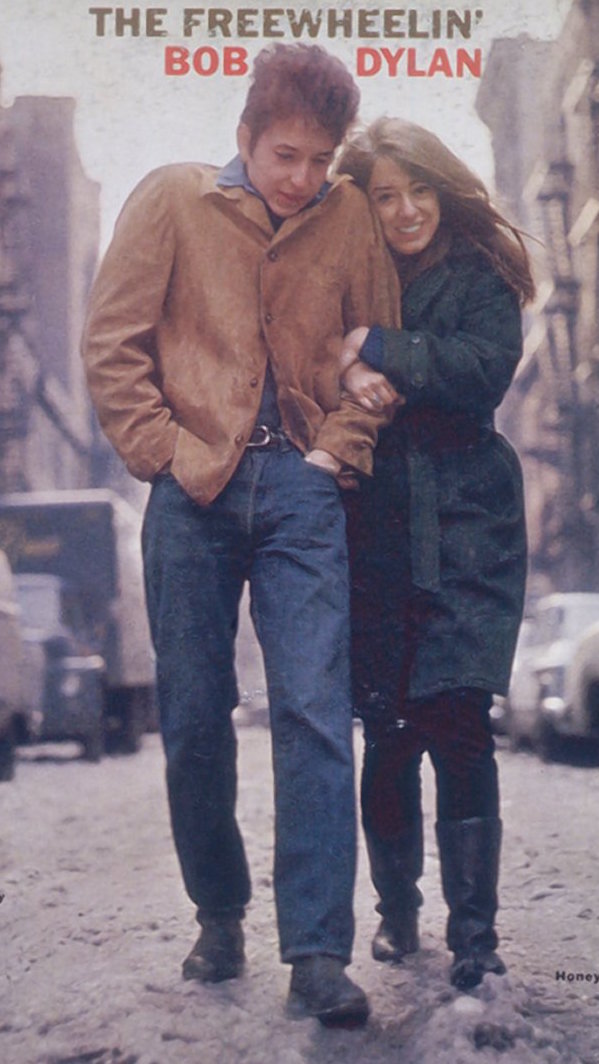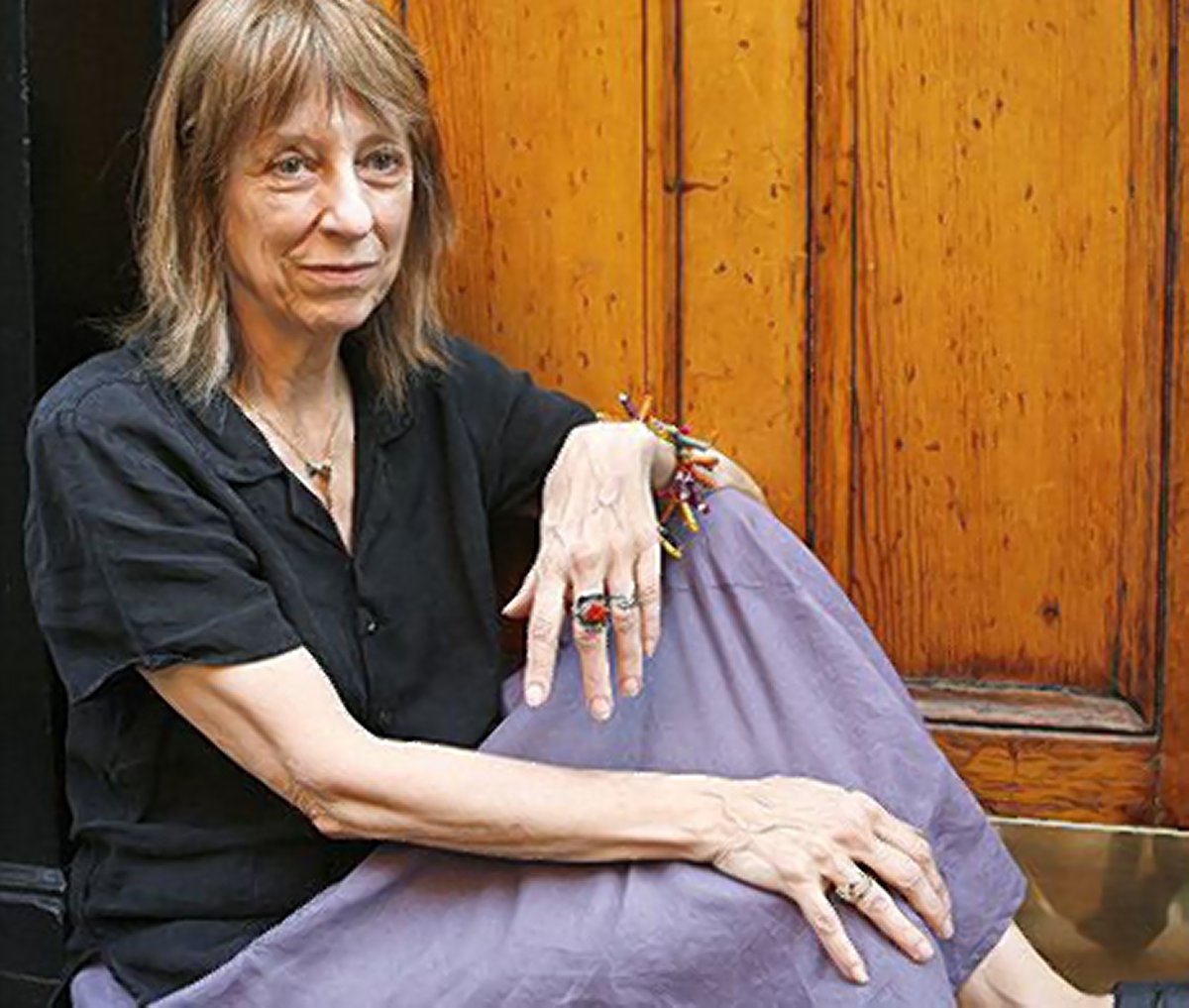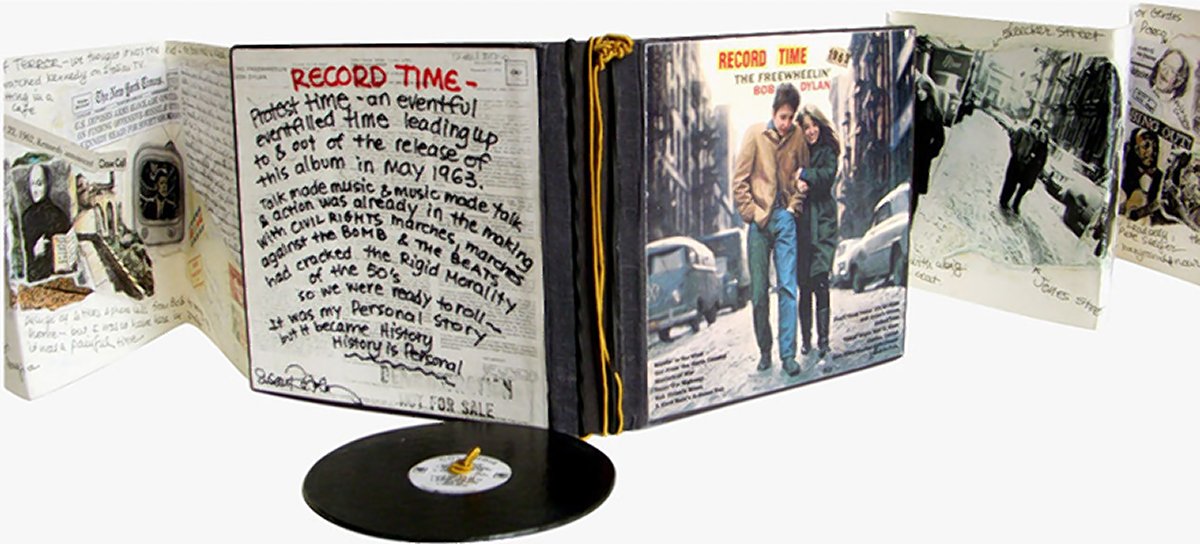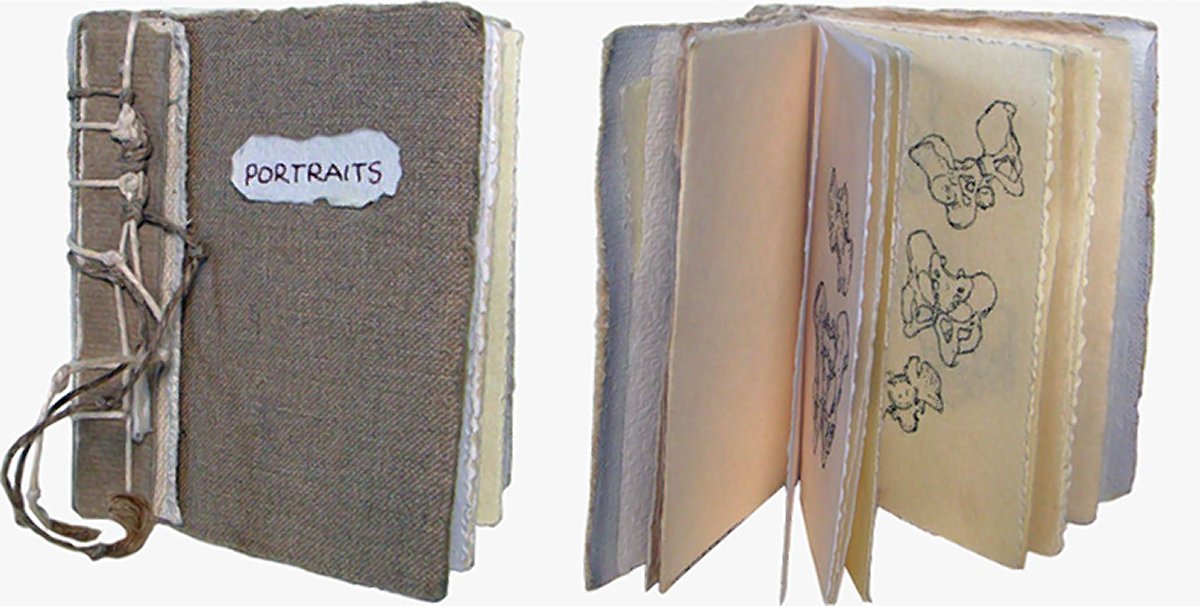
BY MINERVA DURHAM |
‘The new generation causing all the fuss was not driven by the market; we had something to say, not something to sell.’
— Suze Rotolo, “A Freewheelin’ Time” (2008)
Without hat or gloves, their shoulders hunched against the cold, they walk up the middle of Great Jones St. through dirty snow, his bare hands tucked into the pockets of his jeans while her arms circle round his left arm, holding it tight. He leads the way, slightly ahead of her, his head tilted toward her, and she, being a little shorter, leans her head on his shoulder. Their legs march in step, with their left feet suspended in mid-action, pointing up and forward, ready to strike down with their heels, their image frozen for eternity in the sort of transitional gesture that sculptors favor.
He seems lost in thought. Maybe his teeth chatter from the cold, but, clearly, he is not unhappy. She smiles.
“She had a smile that could light up a street full of people,” he wrote about her years later in his memoir.
Looking at the photograph of Bob Dylan and Suze Rotolo in Greenwich Village in 1963, the cover of Dylan’s second album, you can see that they were young and very much in love. You can imagine how cold it was the day that Columbia Records staff photographer Don Hunstein shot the image. It nearly makes you shiver, except that Suze’s smile warms you.
Thirty years after the iconic photo was taken, Stephanie Connell, a retired artist, brought a woman named Susan Rotolo to my Spring Studio. Susan didn’t want to draw the figure with the rest of us. She asked if she could instead draw the bones in my bone collection.
She sat to the side of the room all by herself in the midst of animal and human bones that were to be the most recent subject of her ongoing project. She planned to sew her drawings together by hand to make small art books, inserting an occasional found object.

She worked quietly and diligently. When she smiled, her eyes expressed genuine sincerity. She no longer looked much like the girl in the photo. Her face was thinner than it had been 30 years earlier. She was a little long in the tooth, but attractively so. At first glance, she looked like my sister Alexandra, with the same average height and slender build, and the same fair, honey-haired complexion, so much so, that artists would walk up to her at opening receptions and ask her, “Aren’t you Minerva’s sister?”
I imagine that our families could only be related by blood through redheaded Normans, some of whom conquered England in 1066 and others of whom passed through southern Italy as crusading knights and liked what they saw, so decided to take it over.
I planned an exhibition at Spring Studio of mementos mori, to be shown in March 1996. I called it “Expressions of Mortality from Anatomy to Vanity.” Susan was eager show her hand-stitched books. She joined seven artists who drew the figure at the studio and who also drew bones, dealt with the theme of death, or illustrated medical subjects. All told, the show featured eight artists: Patricia Arrott, Stephanie Connell, Sharon Ellis, Elissa Gore, Rima Jablin, Geoffrey Laurence, Susan and me.
Such was the power of Don Hunstein’s photo on Dylan’s album cover that people kept asking me during the exhibition if the artist in the show listed as Susan Rotolo was Bob Dylan’s girlfriend.
“The record cover,” they would exclaim, “you know, the record cover!”
They wanted to know all about her, but I knew almost nothing except that she was devoted to making her art, had been Bob Dylan’s girlfriend for a few years, was married to someone else, and had a teenage son. Apparently, she was famous among Dylan fans as his mysterious first love. “Don’t Think Twice, It’s All Right,” “Tomorrow Is a Long Time” and “Boots of Spanish Leather” were written for and about her.
Until I read about her in David Hajdu’s book “Positively 4th Street,” I had no idea that the woman named Susan had been a significant person in Bob Dylan’s musical development. Hajdu revealed her to be of good character and deep sensitivity, with plenty of human vulnerability, devoted to the cause of human justice.
It is commonly agreed that she had a strong influence in Dylan’s early songs, deepening his interest in and understanding of French symbolist poets, English-language folk ballads, American protest music, and the lyrics of Berthold Brecht. In her memoir (published in 2008), Susan describes Dylan’s response to the performance of “Pirate Jenny” by Micki Grant, an African-American soprano, actress, writer and composer.
In 1997 Susan exhibited her handmade books at the Jefferson Market Public Library, on Sixth Ave. in Greenwich Village. The show was listed in the Regional section of The New York Times, on October 26, 1997: “ ‘The Book as Art,’ an exhibition by Susan Rotolo, displays books decorated by the artist, including a memoir of the 1960s when Ms. Rotolo, who dated Bob Dylan at the time, came of age.”


While checking out the architecture of the Jefferson Market Library, designed by Frederick Clarke Withers, Mario Maffi saw the show. He wrote about Susan’s “small, magical art books” in “New York City, An Outsider’s Inside View” (published in 2004.)
So, in 1997 Susan Rotolo was coming out of hiding, presenting her story to a small, random audience, telling it in her own way, in unassuming non-commercial, small handmade artists’ books.
It was a start.
In her prose poem, “Record Time,” she places her relationship with Dylan in its historic context of the civil rights struggle, the anti-war movement and the sexual revolution, just before the rise of second-wave feminism. She scrawls, “action was already in the making…so we were ready to roll,” alerting us to her nascent feminism.
Like many American women at the time, Susan was empowered by participating in protest marches. A newfound feminist consciousness allowed her to reject the sort of relationship that she had with Dylan.
Suze used the name Susan Rotolo in relation to her book production and her personal social life for many years. She married Enzo Bartoccioli, a filmmaker at the United Nations. She lived in an apartment on Broadway near Houston St. that she had bought when places in the Village were still cheap.
Not everyone in New York was impressed with Suze’s connection to past glories or with the mystique of the silent former girlfriend of the famous musician/poet. New residents moving into her apartment building complained that her teenage son Luca sometimes played his guitar in the lobby of the building. Their complaints irked her, but she saw the humor in the situation.
Everything was moving upscale, becoming flat and anonymous. She hadn’t wanted to be a legend anyway.
During the years that Suze refused to give interviews to the media, she held close whatever resentment or pain she had. What was there to say? Maybe she talked about the past with Stephanie Connell, who was a big sister/mother figure for her.
Stephanie was nonchalantly sophisticated and great fun to be with, a part of the generation of arty young women who lived in Greenwich Village in the ‘40s and ‘50s that included Virginia Admiral, Julia Ann Crawford, Ruth Herschberger, Alene Lee, Marjorie McKee, Elizabeth Pollet, Dachine Rainer, Edith Stephan, Helen Walker and Elaine Williams.
These women spoke their minds, had brushes with fame, had some success publishing, lived bohemian lives, married famous men and/or gave birth to sons who became famous. By the time I met most of these women through Virginia Admiral, they were minor legends. You might find yourself reading about them in Anais Nin’s memoirs, if nowhere else.
Susan met Stephanie while standing in line at MoMA for free admission on a cold winter day. They struck up a conversation and were deep into it when a guard interrupted them.
“I can’t let Bob Dylan’s girlfriend stand out here in the cold,” he said to Suze. “Come with me into the museum now.”
“Only if my friend can come, too,” Suze said. They became fast friends until Stephanie died in 2008.
With the publication of the first part of Dylan’s memoir, “Chronicles: Volume One,” in 2004, Suze’s resistance to notoriety softened. She appreciated his description of her when he met her, calling it “wonderful, generous” in an interview. She was “the most erotic thing I’d ever seen,” he wrote.
She broke her silence. She agreed to be interviewed for Martin Scorsese’s 2005 documentary “No Direction Home,” which covers Dylan’s career between the years 1961 to 1966.
As luck would have it, Scorcese’s cameraman was sick on the day that Suze was scheduled to be interviewed. My friend and neighbor Lisa Rinzler was called in at the last minute to shoot the interview in Suze’s home. Small talk revealed that Suze had a connection to Spring Studio. Lisa was surprised. She called me and we three made a lunch date. Suze, still essentially a private person, was warm, gentle and intelligent, as usual.
We at Spring Studio who were friends with Suze somehow knew that Dylan had never lost touch with her. Stephanie must have told us, because Suze never spoke his name. We invented a sort of myth about her first love, and it served us until she finally wrote her memoir in 2008 — “A Freewheelin’ Time: A Memoir of Greenwich Village in the Sixties” — and revealed her truths. It pleased us to think that the relationship had ended because Dylan sought fame and abandoned her for Joan Baez, who furthered his career.
We were wrong. Suze felt “like a string” on Dylan’s guitar; her mother and older sister disliked Dylan intensely; feminism was on the rise. She needed to be herself.
Then, there was the abortion.
In the early ‘60s abortion was not legal in New York State yet, or anywhere else in the country. After moving out of their W. Fourth St. apartment, Suze had an illegal abortion.
Every woman from the ‘60s has an unwanted-pregnancy story to tell, hers or her sister’s or her best friend’s, each story unhappy in its own way.
Everything moved quickly after Suze’s book came out. She did interviews and made appearances and was written about favorably. She was an excellent writer, honest and empathetic.
Of the period when she knew Dylan, she wrote, “The 1960s were an amazing time, an eventful time of protest and rebellion. An entire generation had permission to drink alcohol and die in a war at eighteen, but it had no voting voice until the age of twenty-one. Upheaval was inevitable. Talk made music, and music made talk. Action was in the civil rights marches, marches against the bomb, and marches against an escalating war in Vietnam. It was a march out of a time, too – out of the constricted and rigid morality of the 1950s. The Beats had already cracked the facade and we, the next generation, broke through it.”
After Stephanie Connell died in 2008, the same year that Suze’s memoir came out, another of Stephanie’s friends, Eileen Krest, planned to mount a memorial show of Stephanie’s works at Spring Studio to be presented in 2010 with the help of Stephanie’s boyfriend Ron Efron and her son Eric Connell.
I ran into Suze and Enzo on the street.
“I haven’t read your book yet, but I want to,” I confessed.
She smiled her beautiful, warm smile.
“Do,” she encouraged me.
I told her that Eileen and I were working with Ron, doing a memorial show of Stephanie’s drawings and paintings. Suze was excited and offered to help.
But as the show neared we couldn’t reach her. Finally, I got an e-mail from Eileen on Dec. 3, 2010.
Suze just got back to me. She really sincerely wants to come Sun. evening, but she has “not been well” (sounds serious). She told me to tell you both.
Suze missed the opening reception for Stephanie’s memorial show, but I hoped that she could see the show before it came down. I left a few messages on her phone. Enzo finally called to tell me that she was too sick to visit the studio.
Suze Rotolo died of lung cancer at her home on Feb. 25, 2011, at age 67, in Enzo’s arms, we were told.
To see scores of Susan Rotolo’s handmade books online, go to Medialia Gallery’s Web site: www.medialiagallery.com/artists/Rotolo/Rotolo.html

















